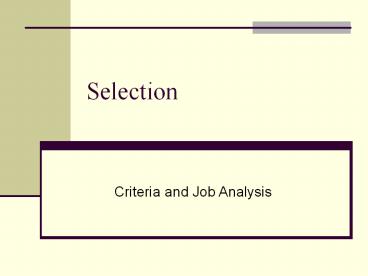Selection - PowerPoint PPT Presentation
Title:
Selection
Description:
Using scientific methodology to choose one alternative (job candidate) over ... Task: build kitchen cabinets. Activity: assemble cabinets. Element: drill holes ... – PowerPoint PPT presentation
Number of Views:97
Avg rating:3.0/5.0
Title: Selection
1
Selection
- Criteria and Job Analysis
2
Selection
- What is selection?
- Using scientific methodology to choose one
alternative (job candidate) over another. - Job Analysis
- Measurement
- Statistics
- Why is selection important?
- Decreases the likelihood of hiring bad
employees - Increases the likelihood that people will be
treated fairly when hiring decisions are made - Reduces discrimination
- Reduces likelihood of discrimination lawsuits
- What do I/O psychologists need to know about
selection? - How to select predictors of job performance
(criteria problem) - How to accurately indentify and validate
predictors for specific jobs (job analysis) - Rely on cognitive and personality variables
- How to reliably and validly measure these
predictors - How to use these predictors to make selection
decisions
3
Criteria
Abstract concept or idea
Conceptual Criterion
- Criteria - standards used to judge the quality of
(discriminate among) alternatives. - For I/O psychologists, this means judging the
quality of employees, programs, and units in the
organization.
Criterion deficiency
Actual Criterion
Criterion relevance
Criterion contamination
Measures that act as proxies
4
Classification of Criteria
- I/O Psychologists try to choose criteria that
assess performance excellence. - Criteria are typically classified in one of two
ways - Objective
- Subjective
- More easily quantifiable
- Production
- Number of touchdowns
- Number of units produced
- Sales
- Tenure/Turnover
- voluntariness
- functionality
- Absenteeism
- Accidents
- Theft
- Judgements made about employees performance
- general factor (effectiveness)
- specific factors
- quantity of work
- quality of work
- Note More complex jobs require more criteria for
effective evaluation
5
Illegal Criteria
- Title VII of the 1964 Civil Rights Act prohibits
using selection practices that have an unequal
impact on members of a different - Race
- Color
- Sex
- Religion
- National Origin
6
Types of Illegal Discrimination
- Disparate Treatment (Opportunities)
- Discrimination decisions based on one of five
prohibited categories - Disparate Impact (Outcomes)
- Illegal discrimination is any practice (without a
business justification) that has unequal
consequences for members of protected groups. - Roger Parloff, Fortune senior editor
- Though disparate treatment and disparate impact
cases are both aimed at eradicating the same
thing, there is potential tension between them. - The goal of disparate treatment cases is to
guarantee every worker equal opportunity, but not
equal outcomes. - The focus of disparate impact cases is on equal
outcomes. - If one pursues equal outcomes too
single-mindedly, one can compromise the principle
of equal opportunity by inducing the use of
quotas.
7
Determining Disparate Impact
- The 4/5ths Rule
- Disparate impact occurs if the selection ratio
for any minority group is less than 4/5ths of the
selection ratio of the majority group
100 male applicants
50 female applicants
20 males selected
50 .16 8
20/100 .20
At least 8 females should be selected
.20 4/5ths(.80) .16
At least 16 of people from minority group should
be selected using a given procedure.
8
Summary
- Criteria
- Reliable and valid predictors of job performance.
- All criteria suffer from
- Deficiency
- Contamination
- Criteria typically classified as
- Objective
- Subjective
- These labels can be misleading
- There are several illegal criteria
- There are two types of illegal discrimination
- Disparate treatment
- Disparate impact
9
Choosing Predictors of Job Performance
- When selecting new employees, I/O psychologists
use criteria that will identify effective
on-the-job performance - Performance is a function of the following
- Knowledge
- Skills
- Abilities
- Motivation
- Situational Constraints
Performance (KSA)Motivation Situational
Constraints
10
Job Analysis
- Describes
- the tasks that are performed
- type of work
- tools used
- working conditions
- human qualities (KSAOs or competencies) needed to
perform the work - Tells us what tasks people do and the knowledge,
skills and abilities they need to accomplish
those tasks.
11
Purposes of Job Analysis
- Recruiting
- Career development
- What does it take to move up?
- Legal defense
- Essential functions What tasks must be done?
- Performance appraisal
- Selection
- What sorts of people should we hire?
- Training
- What knowledge and skills are needed?
- Research
12
Job-Oriented Job Analysis
- Job components (for a carpenter)
- Duty construct houses
- Task build kitchen cabinets
- Activity assemble cabinets
- Element drill holes
13
Person-Oriented Job Analysis
- KSAOs (for a carpenter)
- Knowledge Have information to do a task
- Skill Practiced act or behavior.
- Ability Stable capacity to do task.
- Other personal characteristics personality,
interests, etc.
14
Examples Of KSAOs For Different Occupations
15
Hiring the Best
- Job College Professor
- What are the major duties of a college professor?
- What tasks are performed to complete each duty
- Develop a set of KSAOs necessary for these
tasks. - should be useable for recruiting and evaluating
- Challenges?
- What other information would you want? How would
you get it?
16
Data Collection Approaches
- Questionnaire
- diaries
- Interview
- critical incidents
- Observation
- Analyst does work
Who do you collect data from?
Subject Matter Experts -incumbent -supervisor -co-
worker
17
Occasions for Formal Job Analysis
- Major Restructuring
- after dramatic growth
- downsizing
- new positions
- Large Selection Procedure
- Dramatic changes in technology
- Passage of Time































